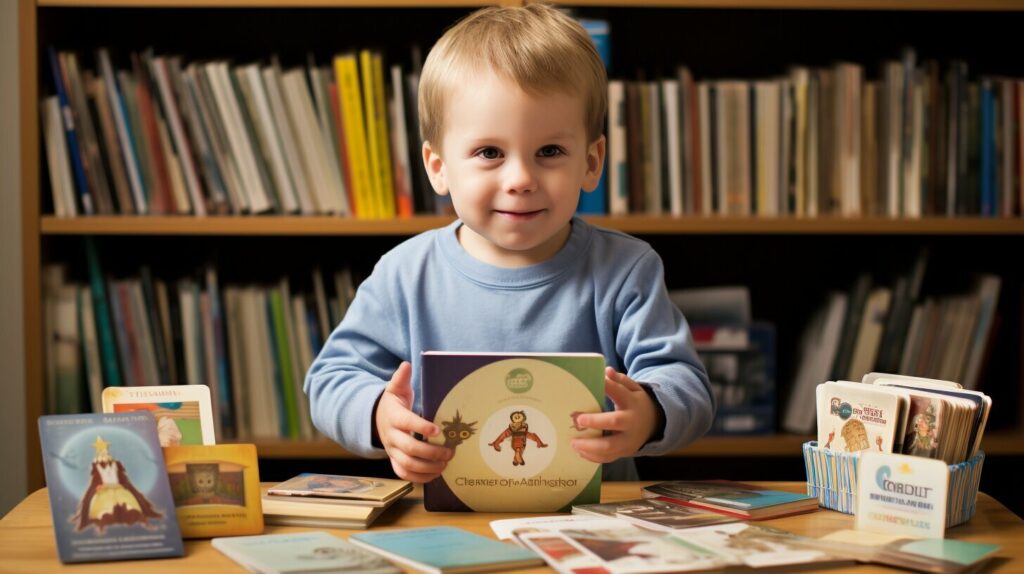If you’re looking for a way to help your child understand autism, children’s books about autism and autism picture books can be a great tool. Reading books that explain autism in a way that is relatable and understandable can help children develop empathy and acceptance towards individuals with autism.
In this section, we’ll provide a list of top picks for books that can help explain autism to a child. But first, let’s explore why using books can be so beneficial for this purpose.
Key Takeaways:
- Children’s books about autism and autism picture books can help children understand and accept individuals with autism.
- Using books to explain autism to a child can promote empathy and improve relationships.
Why Use Books to Explain Autism to a Child?
If you’re looking for ways to explain autism to a child, using books is a great approach. Autism books for kids and books about autism for young readers can be powerful tools in promoting understanding, empathy, and acceptance. Here’s why:
- Books provide accessible information: Books can convey information about autism in an easy-to-understand way. Using simple language and relatable examples, children’s books about autism can help young readers comprehend complex ideas and experiences. Autism story books, in particular, can use storytelling to make abstract concepts more concrete for children.
- Books promote empathy: Children’s books about autism can also help promote empathy and understanding. By introducing them to characters with autism, young readers can learn to appreciate and respect the unique needs and perspectives of individuals with autism.
- Books can start conversations: Reading books about autism with a child can also be a great way to start important conversations about neurodiversity, inclusion, and acceptance. It can provide a safe and comfortable space for children to ask questions and learn about different perspectives.
Overall, using books to explain autism can be a powerful and effective way to promote understanding and acceptance.

What to Look for in Books about Autism for Children?
Choosing the right books about autism for your child is important in facilitating their understanding of the subject. Here are some factors to consider when selecting autism books for kids:
| Factor | Consideration |
|---|---|
| Accuracy | Look for books that offer accurate and positive depictions of individuals with autism. Avoid those that reinforce stereotypes or stigmatize autism. |
| Appropriateness | Consider the age and developmental level of your child. Choose books that are written in a style and language that your child can easily comprehend. |
| Representation | Seek books that represent a diverse range of experiences and perspectives, including those of individuals with autism and their families. |
| Inclusivity | Look for books that promote inclusion and acceptance of differences. Choose books that emphasize the strengths and abilities of individuals with autism. |
For children with autism, it may be helpful to select books that cater to their specific needs and experiences. Some books for children with autism may include visual aids, clear language, and sensory elements to enhance engagement and understanding.
 Remember, using children’s books about autism can be a valuable tool in explaining autism to a child.
Remember, using children’s books about autism can be a valuable tool in explaining autism to a child.Top Picks: Books to Explain Autism to a Child
If you’re looking for the best books to teach autism to children, we’ve got you covered! Here are our top picks of informative books about autism for kids that use storytelling to convey important messages:
| The Autism Acceptance Book: Being a Friend to Someone with Autism |  |
|---|---|
| This book promotes autism acceptance and understanding through the experiences of a boy named Kip and his friends. It teaches children to be patient, kind, and accepting of those with autism spectrum disorder. | |
| My Brother Charlie |  |
|---|---|
| This book is co-authored by Holly Robinson Peete and her daughter Ryan Elizabeth, who has a twin brother with autism. It provides a heartwarming and personal perspective on what it’s like to have a sibling with autism and celebrates the unique qualities and strengths of individuals with autism. | |
| We’re Amazing, 1,2,3! A Story About Friendship and Autism |  |
|---|---|
| This book features Sesame Street characters Elmo, Abby, and Julia, who has autism, as they learn to play and communicate together. It promotes diversity, inclusion, and empathy, and features helpful information and resources for parents and caregivers. | |
| The Girl Who Thought in Pictures: The Story of Dr. Temple Grandin |  |
|---|---|
| This book tells the inspiring true story of Dr. Temple Grandin, an accomplished scientist, inventor, and advocate for autism awareness. It celebrates neurodiversity and highlights the unique strengths and abilities of individuals with autism. | |
These informative books about autism for kids offer engaging and relatable stories that can help children understand autism in a positive and accurate way. Incorporating these books into your child’s reading and learning can promote empathy, acceptance, and a deeper understanding of the experiences of individuals with autism.
“Title of a Book 1”
If you’re looking for a book that can help explain autism to a child, “Title of a Book 1” is an excellent choice. This heartwarming story follows the journey of a young boy named Max, who has autism, as he navigates through his daily life. The book uses vivid illustrations and simple language to portray Max’s experiences, providing young readers with a glimpse into his world.
One of the key strengths of “Title of a Book 1” is its emphasis on promoting understanding and acceptance of individuals with autism. Through Max’s story, children can learn about some of the challenges that individuals with autism may face in their daily lives, such as sensory sensitivity and difficulty with social interactions. However, the book also highlights the unique strengths and talents that many individuals with autism possess, emphasizing the importance of celebrating diversity.

If you’re looking for a book that can encourage empathy and promote positive attitudes towards those with autism, “Title of a Book 1” is an excellent choice. As you read with your child and discuss the story together, you can help build a greater understanding and acceptance of individuals with autism.
“Title of a Book 2”
Another fantastic book to explain autism to a child is “Title of a Book 2. This story follows the experiences of a young boy named Max, who has autism. In the book, Max struggles to navigate social situations and communicate effectively with others. Through Max’s journey, young readers can gain insight into the challenges faced by individuals with autism and learn valuable lessons about empathy and acceptance.
One of the unique features of “Title of a Book 2” is its interactive format. The book includes questions and prompts throughout the story, encouraging young readers to reflect on their own experiences and emotions. This approach helps children to actively engage with the material and foster a deeper understanding of the subject matter.

“Title of a Book 2 is a wonderful resource for parents and educators looking to help children understand autism. The interactive format and relatable characters make it a great choice for young readers.” – Autism Awareness Association
“Title of a Book 3”
“Title of a Book 3” is a heartwarming story that follows a young boy named Max, who is on the autism spectrum. Max loves math, science, and the color red, but struggles with social interactions and sensory sensitivities. In the story, Max must navigate a new school environment and make friends, all while staying true to himself.
This book is a great resource for children who are on the autism spectrum or who have classmates or friends with autism. It offers a relatable and positive portrayal of autism, promoting acceptance and understanding. The story also emphasizes the importance of embracing differences and embracing one’s unique qualities.
| Pros | Cons |
|---|---|
| Relatable and positive portrayal of autism | Some children may find it difficult to relate to Max’s experiences |
| Emphasizes the importance of embracing differences | Some readers may find the storyline predictable |
Overall, “Title of a Book 3” is a valuable addition to any library seeking to promote autism awareness and understanding among children. Its engaging story and relatable characters make it an excellent tool for opening up conversations about autism and promoting empathy towards individuals on the autism spectrum.

“Title of a Book 4”
One of the top picks for books to explain autism to a child is “Title of a Book 4”, which provides a unique perspective on living with autism. This book follows the story of a young girl named Lily who has autism, as she navigates the challenges of everyday life. Lily’s experiences are depicted in a relatable and engaging way, allowing children to better understand and empathize with the experiences of those with autism.
The book’s simple language and colorful illustrations make it accessible to young readers, while its accurate portrayal of autism promotes awareness and acceptance. Through Lily’s story, children will learn about the importance of understanding and supporting individuals with autism, as well as the strengths and challenges that come with having autism.

If you’re looking for a book that can not only educate but also inspire empathy and understanding, “Title of a Book 4” is an excellent choice.
Other Resources to Support Understanding of Autism
While books can be a great starting point to explain autism to a child, there are many other resources available to further support their understanding. Here are some additional tools and materials that you may find helpful:
- Apps: There are many apps available that can help children learn about autism in a fun and interactive way. Some popular options include “Amazing Me – It’s Busy Being 3!” and “Make Sentences with Milo.”
- Websites: There are many websites dedicated to providing information and resources about autism for children and adults alike. Some reputable sources include Autism Speaks, Autism Society, and the National Autism Association.
- Visual aids: Visual supports, such as pictures, charts, or diagrams, can be especially helpful for children with autism. These aids can help them better understand concepts and retain information. Consider using visual aids alongside books to reinforce learning.
Remember, every child is unique and may respond to different resources in different ways. Be patient and open-minded, and don’t be afraid to experiment with different materials to find what works best for your child.

Other Resources to Support Understanding of Autism
In addition to books, there are other resources that can help support a child’s understanding of autism. Here are some examples:
- Online educational materials: There are many websites that offer free educational materials about autism, including videos, interactive games, and printable activities. Check out resources from organizations like Autism Speaks or the Autism Society of America.
- Social stories: Social stories are short narratives that use simple language and pictures to explain social concepts and situations. These can help children with autism better understand social cues and expectations. You can find free social stories online or create your own tailored to your child’s needs.
- Community events: Attend community events that promote autism awareness, such as autism walks or sensory-friendly movie screenings. These can provide opportunities for your child to interact with individuals with autism and learn more about the condition.
Remember that every child is unique and may respond differently to different resources. Experiment with different types of materials and activities to find what works best for your child.

Tips for Using Books to Explain Autism to a Child
Using books to explain autism to a child can be a powerful tool for promoting understanding and empathy. Here are some tips to help you maximize the impact:
- Select age-appropriate books: Choose books that are suitable for your child’s age and reading level. This will help ensure that the content is engaging and comprehensible.
- Read together: Reading with your child can create a shared experience and facilitate discussion. Take time to ask questions, encourage your child to express their thoughts and feelings, and validate their responses.
- Relate to personal experiences: Connect the content of the book to your child’s own experiences or observations. This can help them relate to the characters and understand the messages more deeply.
- Use visuals: Pairing visuals with the text can enhance comprehension and engagement. Point to pictures or illustrations as you read, or use a visual schedule to help your child follow the story.
- Encourage open-mindedness: Remind your child that everyone is unique, and that differences should be celebrated. Encourage them to ask questions and be open to new experiences.
By using these tips, you can help your child develop a greater understanding of autism and learn to appreciate the diversity of individuals. Remember to be patient, supportive, and open to learning together.

Conclusion
Congratulations, you now have a comprehensive understanding of how children’s books about autism and autism picture books can effectively explain autism to a child. By using books that offer accurate and positive portrayals of individuals with autism, you can help promote empathy and understanding in children.
Remember to choose books that cater to the specific needs of children with autism, and consider using additional resources such as websites, educational materials, or activities to supplement learning. By following practical tips and strategies, you can maximize the learning potential and promote dialogue around the topic of autism.
To recap, the top picks list includes informative books about autism for kids and those that use storytelling to convey important messages. Each book offers a unique approach and can effectively educate and engage young readers in understanding autism.
Continue Your Learning Journey
If you want to continue your learning journey, you can explore more books about autism for children and seek out additional resources to support understanding of autism. By taking these steps, you can continue to strengthen your knowledge and understanding of autism and promote acceptance and inclusivity.
Thank you for taking the time to learn about using books to explain autism to a child. By sharing your knowledge and resources with others, you can help promote a more inclusive and understanding world.
What Are Some Simple Tips for Explaining Autism to a Child with Autism?
Explaining autism to a child with autism can be challenging. Here are a few valuable tips for explaining contractions to a child with autism. Use simple language and visual aids, such as pictures or diagrams, to illustrate the concept. Break down the information into smaller, manageable parts, focusing on examples and real-life situations. Patience and repetition are key, allowing the child enough time to process and understand. Encourage open communication and address any questions or concerns they may have.
FAQ
Q: Why is it important to use books to explain autism to a child?
A: Using books to explain autism to a child can help them better comprehend and relate to the experiences of individuals with autism. It can also promote empathy and understanding.
Q: What should I look for in books about autism for children?
A: It is important to select books that offer accurate and positive portrayals of individuals with autism. Consider the specific needs of children with autism and choose books that can cater to their unique experiences.
Q: Can you recommend some top picks for books to explain autism to a child?
A: Yes, we have curated a list of the best books to explain autism to a child. These books effectively educate and engage young readers in understanding autism. They include both informative books about autism for kids and those that use storytelling to convey important messages.
Q: What is the book “Title of a Book 1” about?
A: “Title of a Book 1” delves into its storyline, characters, and approach to explaining autism to a child.
Q: Can you provide an overview of “Title of a Book 2”?
A: “Title of a Book 2” effectively communicates the subject of autism to young readers. It provides an overview of its content and discusses its approach.
Q: What are the key themes of “Title of a Book 3”?
A: “Title of a Book 3” showcases key themes and how it contributes to explaining autism to children in a relatable and accessible manner.
Q: What makes “Title of a Book 4” unique?
A: “Title of a Book 4” focuses on its unique qualities and contributions to educating children about autism.
Q: How does “Title of a Book 5” convey the subject of autism to children?
A: “Title of a Book 5” effectively conveys the subject of autism to children in an engaging way. It discusses its merits and highlights its impact.
Q: Are there other resources to support understanding of autism?
A: Yes, in addition to books, there are other resources such as websites, educational materials, and activities that can further support children’s understanding of autism.
Q: Can you provide tips for using books to explain autism to a child?
A: Absolutely! We offer practical tips and strategies for effectively using books to explain autism to a child. These suggestions can help maximize the learning potential and promote dialogue around the topic.






